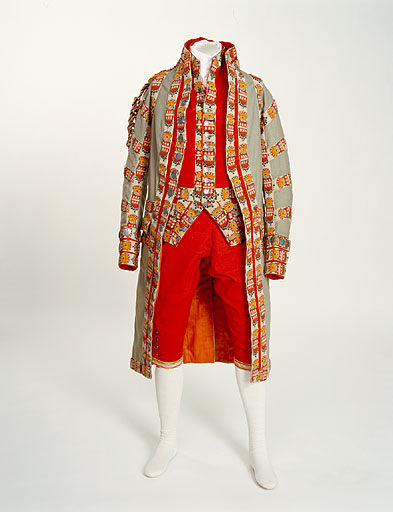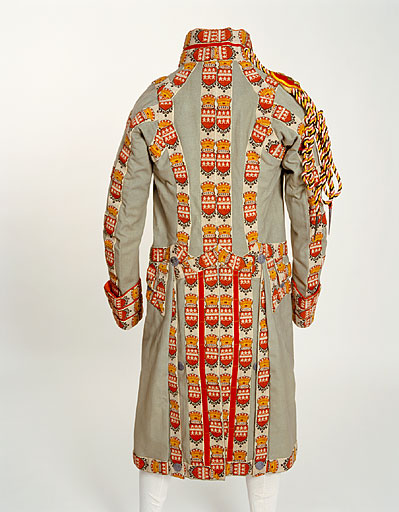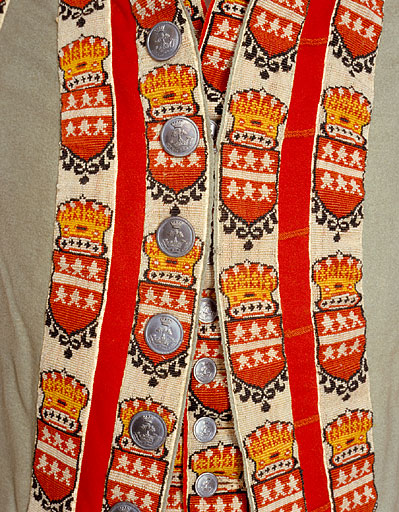footman's livery uniform
Summary
Coat: Light blue-green cloth trimmed with red cloth and wool braid with uncut pile woven with coat of arms and coronet in red, yellow and black on white; lined with red glazed twilled wool; high standing collar; fronts each in one section, fastening at chest with 2 hooks and eyes, 17 metal buttons on right edge from neck to hem, cord imitating buttonholes on left, pocket at waist each side with shaped flap over three buttons; back in two shaped sections with centre back vent; long sleeves in two sections lined with white cotton, collar and turned-back cuffs of red cloth, strip of red cloth each side of front and centre back opening; braid on all edges and seams, outlining pockets and in chevrons down outside of sleeves; two loops white, red and yellow silk cord with metal points attached to right shoulder under crest embroidered in coloured silks on red cloth; Breeches: Red cloth; shaped waistband lacing over gusset at centre back, fastening at centre front with 3 plain buttons under flap fastening with two buttons on waistband and one of centre front buttons; pocket each side with small button at corner on hip; narrow pocket in waistband on right of centre front; horn buttons for braces each side front and back; legs fastening at outer knee with four buttons and coloured silk braid kneeband with slot for buckle. Waistcoat: red cloth lined with white cotton; front and skirt faced with red glazed wool; fronts each in one section fastening to waist with small metal buttons, buttons continue above and below fastening, high standing collar, fronts cut away at angle below waist, pocket each side of waist with shaped flap over three buttons; back in two sections, centre back vent; two pairs of linen tape ties at waist; collar, fronts and pockets edged with same braid as coat. Made for the attendants of the 3rd Earl of Ashburnham of Ashburnham Place, Sussex, in 1829 for his installation as Knight of the Garter
Display Label
Men working in domestic service throughout the eighteenth and nineteenth centuries often wore a distinctive clothing, unlike their female counterparts. Uniforms were especially popular in the wealthier households and for public duties such as attending the carriage or serving at a very formal dinner. Families were able to invent their own style of uniform, sometimes very extravert indeed. This blue green and scarlet outfit, heavily braided and decorated, was designed in 1829 for the footman of the 3rd Lord Ashburnham on the occasion of his being appointed a Knight of the Garter. Such an honorific and public occasion required the height of formality and this flamboyant uniform was intended to reflect the wealth and prestige of the Earl himself. By the middle of the nineteenth century, such extravagant liveries became less popular, increasingly seen as vulgar and old fashioned. Much more sober colours and styling became the norm, as in menswear generally, and families that insisted on retaining their dramatic liveries were then lampooned in magazines like 'Punch' for their pomposity. There was also ridicule for the propensity for male staff in larger aristocratic households to become "high flown" and grandiose, preening themselves before appearing for their public duties (see below).
Object Name
footman's livery uniform
Date Created
1820-1830
Dimensions
Coat: 115cm
Waistcoat: 62.5cm
Breeches: 76.5cm
accession number
1962.42/3
Place of creation
Europe
Medium
Legal
© Manchester Art Gallery



